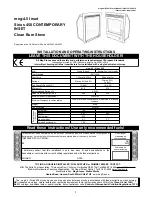
CONDENSATION
onto cool surfaces inside the stove can be
severe if fuel is in any way damp.
Use only very dry fuel.
OVER-FIRING:
It is possible to leave the fire too long with the
controls set too high leading to 'over firing', seen as glowing metal
parts, excessive chimney temperature and risk of parts failing or
chimney fires. Always set controls to the lowest practical setting. A
chimney thermometer, from your local stove shop, can help.
SMOKE COMING INTO ROOM
Fumes are poisonous- smoke
emission must NEVER be tolerated, causes might be:
NEW STOVE: There is often a smell and sometimes visible fumes
as the paint cures. This normally stops after an hour or so.
INADEQUATE SEALS: Are all flue pipes and connectors
absolutely
gas-tight? Even the tiniest crack or gap can spoil the
draught. Does an inset appliances fully seal against the fireplace?
BLOCKED THROAT PLATE: Has soot and ash collected on the
'throat plate' above the inner back part of the firebox?
UNSUITABLE, BLOCKED OR UN-SWEPT CHIMNEY: The first
requirement for correct operation is a sound chimney. Check the
requirements earlier in this document and in any case of doubt
engage a professional sweep or chimney engineer.
POOR AIR SUPPLY: Lack of air to the fire is a common cause of
smoking and poor performance. Air supply problems may be
worse in certain wind conditions (often incorrectly ascribed to
'downdraught', which is in fact very rare), where air can be sucked
out of the room. The answer is to fit an air vent, as near to the fire
as possible, facing into the usual wind direction.
DOWNDRAUGHT: Wind can blow
down
a chimney if there is
something higher nearby such as a tree, hill or high building.
Fitting an anti-downdraught cowl to the chimney top can cure this.
Types which cannot be swept through are not recommended.
POOR CHIMNEY DRAUGHT- Chimney draught in use MUST be
at least 12Pa.
CHIMNEY FIRE:
In the rare event of deposits inside the chimney
igniting (roaring sound + dense smoke and sparks from the
chimney) immediately close the door, shut all air controls and call
the fire brigade. Prevent fires by using
very dry fuel
and having
your chimney swept regularly.
MAINTENANCE
MONTHLY
- Check that the flue is clear and unblocked, and that
the door seals are sound.
ANNUALLY- SWEEP THE CHIMNEY
The entire length of the
chimney from stove to outlet should be swept annually, more often
if smoky fuels are used.
NEW PARTS
Your stove has been extensively tested for safety -
please don't try to modify it and always obtain genuine spare parts
.
SURFACE FINISH
Wipe the stove body with a slightly damp cloth
when cool. NEVER use aerosol spray or wax near the hot fire –
they can ignite. Painted steel parts can be refurbished using
special spray stove paint.
Your stove generates VERY high temperatures. Eventually the
internal parts will require replacement. Help parts to last by:
●
Using only recommend,
very dry
, fuels.
●
Emptying the ash very regularly when using mineral fuel
-never allow it to touch the underside of the grate.
●
Cleaning the internal flueways regularly.
●
Avoiding 'over-firing'
PARTS AND ACCESSORIES
Replaceable parts, shown below, are identified by name and by the model number: meg 4.5 Inset / 450 Inset.
Designed, developed and built in England
Meg Stoves, Station Works
Hooton Road, Hooton, South Wirral CH66 7NF
www.megfire.com
4
The Meg stove designs are registered at the UK Patent Office and protected by Copyright © and UK Design Right, Glyn Hughes 2006-2009. Certain parts are UK Patent Applied For.
This document Issued 13/01/2012. We are always striving to improve these products and may change their specification without notice.
Access to flueways for inspection




